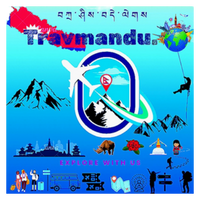“Discovering Mustang, Nepal: A Land Beyond the Himalayas”
- Tennzin Sherpa
- Jul 7
- 4 min read
Updated: Jul 9
Mustang is one of Nepal’s most mysterious and enchanting regions — a place where the high Himalayas meet ancient Tibetan culture, and where every trail tells a story. Located in the remote northwestern part of the country, Mustang is divided into Lower Mustang, known for its accessibility and sacred sites like Muktinath, and Upper Mustang, the former forbidden kingdom with walled cities, cave monasteries, and untouched traditions. Its landscape is unlike anywhere else in Nepal — dry, dramatic, and endlessly fascinating. Whether you’re a trekker, spiritual seeker, or cultural explorer, Mustang offers an unforgettable journey into the soul of the Himalayas.

Muktinath: A Sacred Pilgrimage

Muktinath, a sacred site for both Hindus and Buddhists, is a highlight of any trip to Mustang, Nepal. The temple complex is a spiritual oasis, providing a tranquil retreat for all who visit.
✨ Why It's Special:
It’s one of the few places on Earth where all five elements — earth, fire, water, sky, and air — are represented naturally.
Pilgrims from India, Nepal, Tibet, and beyond come here for spiritual cleansing.
Even non-religious travelers find the atmosphere deeply peaceful and powerful.
Kagbeni: The Gateway to Upper Mustang
Kagbeni, located at the confluence of the Kali Gandaki and Jhong rivers, is the gateway to the upper Mustang. Known for its medieval feel and Tibetan influence, Kagbeni is a must-visit.
Marpha: The Apple Kingdom

Marpha, known as the apple kingdom of Nepal, is famous for its delicious apples and apple products. A stroll through the village streets is like walking through an orchard, with apple trees lining the way.
How to get to Upper Mustang?
Getting to Upper Mustang involves a multi-step journey, usually starting from Kathmandu, the capital of Nepal. Here are the general steps:
From Kathmandu to Pokhara: You can take a tourist bus, private car, or a domestic flight from Kathmandu to Pokhara. The bus ride usually takes about 6-7 hours, while a flight is approximately 30 minutes.
From Pokhara to Jomsom: From Pokhara, you will need to take a 20-minute flight to Jomsom. This small town is the starting point for many treks in the Mustang region.
From Jomsom to Kagbeni: Kagbeni is the gateway to Upper Mustang. You can reach Kagbeni from Jomsom by trekking (approximately 3-4 hours) or by jeep.
From Kagbeni to Upper Mustang: From Kagbeni, you will need to trek or drive further into the Upper Mustang region to reach destinations like Lo Manthang.
Permit and Entry Fee for Upper Mustang
As of my knowledge cutoff in September 2021, traveling to Upper Mustang requires two permits:
Restricted Area Permit (RAP): This permit is required to enter the restricted areas of Nepal, including Upper Mustang. The cost of the RAP for Upper Mustang is USD 500 per person for the first ten days. If you plan to stay more than ten days, an additional fee of USD 50 per day is charged.
Annapurna Conservation Area Permit (ACAP): Since Upper Mustang lies within the Annapurna Conservation Area, you will also need an ACAP. The cost of this permit for foreigners is NRS 4,000 (about USD 35).
Please note that prices and regulations can change, so it’s essential to check the most up-to-date information from a reliable source or your chosen trekking agency before planning your trip. You will also need to be part of an organized tour or accompanied by a registered guide to visit Upper Mustang due to its status as a restricted area.
How to get to Lower Mustang?
Getting to Lower Mustang also involves a journey from Kathmandu, usually with a stop in Pokhara. Here are the typical steps:
From Kathmandu to Pokhara: The journey from Kathmandu to Pokhara can be made by tourist bus, private vehicle, or domestic flight. The bus journey typically takes around 6-7 hours, while a flight is about 30 minutes.
From Pokhara to Jomsom: From Pokhara, a 20-minute flight to Jomsom is usually the most convenient way to reach the Mustang region. Jomsom is a common starting point for many treks and trips in the area.
From Jomsom to various destinations in Lower Mustang: Depending on your itinerary, you may trek or take a jeep from Jomsom to various destinations in Lower Mustang, such as Kagbeni, Muktinath, Marpha, and others.
Permit and Entry Fee for Lower Mustang
Lower Mustang is not a restricted area like Upper Mustang, so it doesn’t require a Restricted Area Permit. However, you will need the Annapurna Conservation Area Permit (ACAP) because the region is part of the Annapurna Conservation Area. Here are the details:
Annapurna Conservation Area Permit (ACAP): This permit is mandatory for all trekkers visiting the Annapurna region, including Lower Mustang. The cost of this permit for foreigners is NRS 4,000 (about USD 35).
As always, it’s important to verify the most recent permit requirements and fees from a reliable source or your trekking agency, as these can change over time.
Best Time to Visit Mustang, Nepal
✅ Spring (March to May)
Weather: Pleasant temperatures and clear skies
Highlights: Blooming rhododendrons in Lower Mustang, ideal for trekking
Events: Tiji Festival in Upper Mustang (usually in May) — a rare cultural experience
✅ Autumn (September to November)
Weather: Crisp, clear days and fantastic mountain views
Best for: Trekking, photography, and exploring both Upper and Lower Mustang
The Unparalleled Beauty of Mustang
Mustang, Nepal, with its unique blend of natural beauty and cultural heritage, is a destination like no other. From the sacred Muktinath to the picturesque Dhumba Lake, from the ancient city of Lomanthang to the bustling Jomsom, every corner of Mustang offers a unique experience. So, when are you planning your trip to this untouched paradise?
Ready for an unforgettable journey? Don’t wait! Contact us to book your trip, and embark on the adventure of a lifetime.



Comments